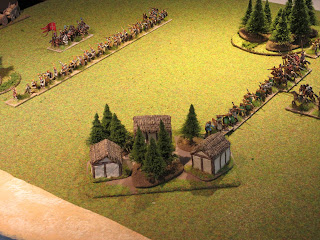540 AD
Following their victory over Childebert at Bayeux, the
Breton army returned to Armorica where they remained for the rest of this
period. More families migrated to the Saxon and Frisian settlements giving both
Childebert and Chlothar pause to negotiate treaties with their respective
intruders.
542 AD
Content that the migration issue would remain quiet, both
Childebert and Chlothar make plans to retake the lands of Aquitaine lost to
the Visigoths in recent campaigns. Later that year, heading the appeals from
the Thuringian nobles Theudebert leads an army to confront the Bavarian
invasion.
543 AD
Encountering an Ostrogothic revival in Italy, the
Byzantines request the support of their ‘allies’, the Franks to deal with them.
In reply, Theudebert would send troops as quickly as the current internal and
external conflicts could be resolved and so Belisarius made plans to campaign
in the following year.
During the summer, the combined forces of Childebert
and Chlothar meet the Visigoths south of Orleans. Fought near the Loire River,
the Neustrian army is defeated by the Visigoths forcing both Frankish kings to
retreat to their respective domains.
Across the
Rhine, Theudebert with Thuringian allies engage the Bavarians near Giessen and
soundly defeat them killing their king. The realm of Thuringia now becomes part
of the kingdom of Austrasia which should deter any further threats by the
Bavarians.
544 AD
The defeat in Aquitaine coupled with the Breton, Saxon
and Frisian incursions has spurred a wave of discontent among the nobles of
Neustria tantamount to open rebellion. Not only has the commercial trade been disrupted
by piracy but the rising cost to support the ineffectual wars is proving a
tipping point for the disaffected nobles; the situation is quite similar in the
fiefdom of Chlothar. The situation leads both sides to raise armies and these
met to do battle a day’s march from Paris. The defeat of the royal army sent Childebert
to seek the safety behind the walls of Paris with the rebels in pursuit. Heartened
by the news of Childebert’s defeat, the nobles of Reims rise in revolt against Chlothar.
Those armies met in August and rebel forces defeated Chlothar near the River Aisne. Leaving his troops to their fate, Chlothar fled to his
capital at Reims and sent messengers to his nephew, Theudebert, for help.
545 AD
Rebel forces besieging both Paris and Reims disperse
before the winter snows and vow to return next spring to resume their fight. Theudebert
used the winter period as to how best to aide his treacherous uncles news
arrived of Childebert’s death (assassination?). Aware that Childebert had no
heir to succeed him, Theudebert moved quickly to Paris to set himself as regent
until the question of a successor could be resolved. Chlothar was in no
position to contest this decision as he would not stir far from Reims with
hostile nobles moving about the land.
548 AD
Three summers have passed and the diplomatic skills of
Theudebert have gain fruition arranging the union of his son and heir to
Chrodoberge, the eldest daughter of Childebert; a union that would expand the
Austrasian realm already increased by the recent acquisition of Thuringian
lands. Burgundy was now a staunch ally, however, regaining Aquitaine would
require some thought as the Visigoths were led by capable generals and have not
been defeated in open battle.
As the calendar approaches the next decade (turn 5)
good news appeared on the horizon as the majority of Saxon and Frisian activity
now moved across the channel finding Britannia a richer prize.




































